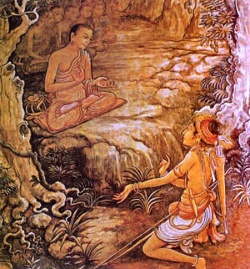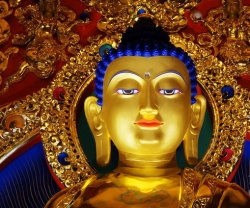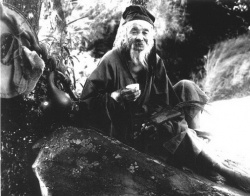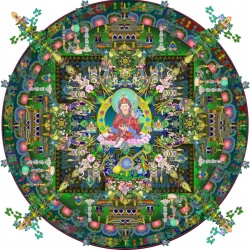Kusen?
About the oral teaching during zazen,
by Kojun Kishigami Osho.
Question 1: Earlier, we all did zazen together and you led the zazen in silence. I’d like to know if you use the kusen, if you knew it from Kodo Sawaki, and if this practice is widespread in Japan. Kishigami Osho: I know that Deshimaru often used the kusen, at almost every zazen. The kusen has been part of Soto School tradition since the Edo era in the 17th century, down to modern times. It is almost the same as a teisho [lecture]. But during the ten years I was with Master Sawaki, at Antai-ji and elsewhere in other temples, he never gave us a kusen. When he was younger, it is possible that he gave kusen when he went to other temples.
Master Sawaki held to the principle that the main goal of zazen was to allow each person to attain the state of Buddha, and for him, people were not to be disturbed during zazen. However, during sesshin, he did sometimes say a few words for one or two minutes to correct the people practicing – telling them to sit up straight, for example. But that would not correspond to the kusen in the strict sense of the word.
As an illustration, when I was on sesshin in Sweden in May and Hugues Naas was the godo, I made some noise with my nose, and the godo said, “Be silent!” [laughter] It’s the same thing. But, I repeat, Kodo Sawaki never talked for more than five minutes [during zazen). If the master wanted to say something, we had to organize a time for a teisho outside of zazen.
The teisho is when the master explains the correct posture, for example, or an excerpt from Shakyamuni Buddha’s teaching, to put those practicing into the best possible conditions for doing zazen. But I will say that the two are not mixed: teisho and zazen are like two wheels on the same vehicle, but we don’t mix them; we let zazen happen during the time for zazen.
Since I was not with Master Deshimaru when he was in France, I imagine that he would probably have inherited a part of Soto tradition when he gave his kusen. Since Deshimaru was older than me – by 26 years – and had started the practice at a young age, I did not know him when he was young. What I imagine is that probably the younger Deshimaru gave very short kusen and wanted to apply the experience of the kusen to his teaching in Europe.
I imagine that the reason why Taisen Deshimaru gave kusen was to make it easier for Europeans to better understand what Zen mind is in a limited amount of time.
A book written about Taisen Deshimaru was published in the United States. One of my friends, Yukako, was to read this book and received a copy in English. According to this book, Kodo Sawaki began to give kusen and proscribed this practice to Deshimaru. Yukako asked me if this was true or not.
It is false. It was not Kodo who began [using the kusen]: it was part of the existing tradition of the Soto School, but he did not use it. He thought it was better to separate the two. There seems to be some conflicting information about these two great masters. As far as correcting the posture of every disciple is concerned, this has been well-transmitted in France.
Question 2: Have you yourself experienced a kusen during zazen, one that was more than a correction, and did it disturb you?
Osho: When I went to Eihei-ji, one godo or another spoke, then the tanto [assistant educator], etc. Then the kyosakuman gave the kyosaku: “bam bam bam!” I couldn’t do zazen peacefully! For me, too much kusen is even more bothersome than somebody snoring in their sleep. [laughter] The content of these kusen is far from the original Buddhist teaching: they are just opinions and personal commentaries, like essays.
As far as Taisen Deshimaru is concerned, the content of his kusen would have been consistent, but the so-called masters in Japan don’t say much of anything as far as I know. So, if you have ideas to spread to others, in my opinion you should organize teisho for that. That’s my opinion.
Q2: My experience with the teisho and the kusen is completely different. The kusen is never a logical sequence with one sentence following another and an intellectual development.
Osho: It’s something that emanates from the body.$
Q2: And I think that the person giving it is surprised himself by what he says. That’s what I experienced with Deshimaru, with Philippe and sometimes with myself.
Osho: Yes, it is possible that that could happen.
Question 3 [Philippe Coupey, addressing the person who asked the first question]: You asked this “explosive” question: what do you think of the kusen?
Q1: : I really like hearing the kusen – sometimes I don’t like it, but I don’t think about it that way during zazen. I realize that often – especially when I hear Philippe speak in the dojo – my posture, my breathing and my state of mind are transformed while I’m hearing the kusen.
Osho: Yes, the goal of the kusen is to bring you back to the ideal zazen state when you are a little foggy, sleepy or distracted. The effect of the kusen is limited to the initial phase of the true depth of zazen; it is understandably effective for beginners who are not in the deep phase of zazen. But, little by little, as the nature of zazen deepens, the kusen becomes less necessary.
Q1: My experience is that the words used, for example when Philippe talks about the Shinjinmei, the Fukanzazengi or poems by Daichi… .
Osho: Yes, the kusen is effective to bring someone back to Zen mind, back to the essence of Zen, through poems for example. How long does a kusen usually last?
Q1: Sometimes it can last twenty minutes. But it has a rhythm – a sentence begins and then ends a minute later, because it’s not aimed at the reflective brain, but at a part of the brain that is not in the process of arguing.
Osho: Yes, during zazen, it is not something logical, but the realm of instinct. When you are truly absorbed in zazen, it takes a few seconds to come back to a normal state.
Sometimes I receive telephone calls when I have been practicing zazen for two hours in the morning or evening. Once it was my brother, who said to me, “You were asleep!” “No, I was doing zazen!” During zazen we put all our sensory systems to rest and we are really absorbed in the heart of ourselves.
Q1: That’s why I think that a kusen can really subvert my value and belief systems, whereas with a teisho, it’s harder.
Osho: It is possible that this occurs, but Shakyamuni Buddha would not have used this method. And according to what I have studied, apparently Master Dogen didn’t use it either. In the Soto tradition, some beginners needed it: that’s why it exists.
Maybe Taisen Deshimaru judged the kusen a useful means to help Westerners understand Zen, and he used it out of kindness – it came from his benevolent spirit. I would say that the subjects used in kusen in France or Europe serve a purpose, while in comparison, in Japan it’s a lot of nonsense. Aside from Kodo Sawaki’s disciples, other masters did not inherit true, authentic Zen. [laughter]
During a sesshin, when beginners or first-timers are present, we must explain for a quarter of an hour. But amongst experienced colleagues… First we have tea together to calm the agitation of traveling, but then we can do zazen peacefully. For people who have gone deeper, words are no longer needed.
So, it depends on the circumstances. My goal is not to judge what is good or not good, seen from the outside, or to say that you must abandon the kusen. Just act according to what is needed.




